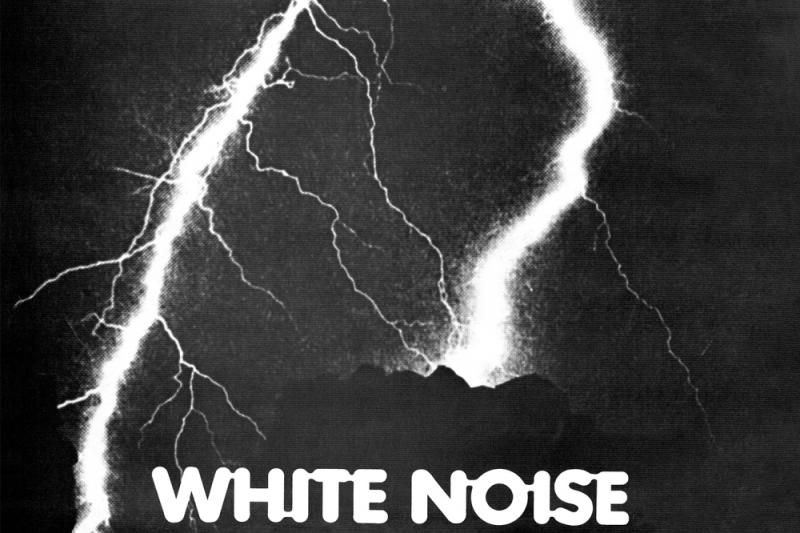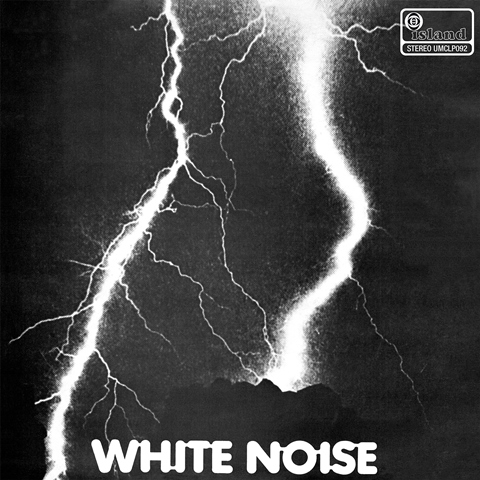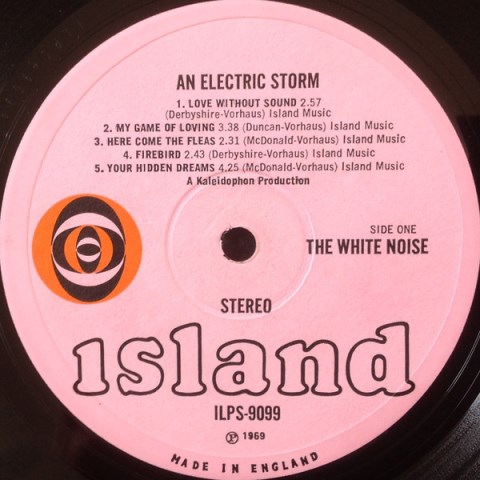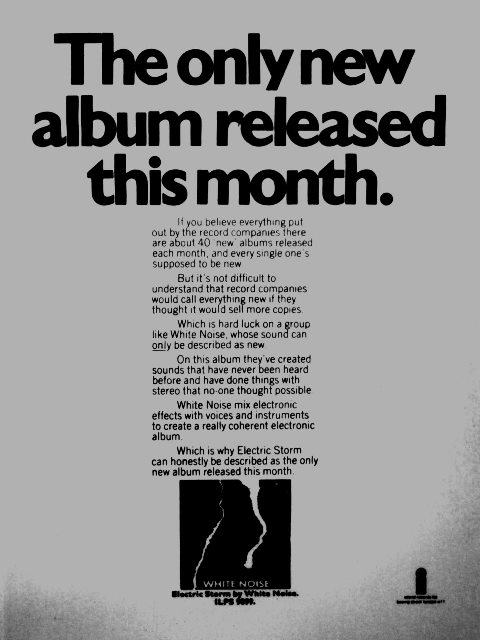Music Reissues Weekly: White Noise - An Electric Storm | reviews, news & interviews
Music Reissues Weekly: White Noise - An Electric Storm
Music Reissues Weekly: White Noise - An Electric Storm
BBC Radiophonic legend Delia Derbyshire climbs on board for a tilt at the pop market

An Electric Storm opens with “Love Without Sound.” Once heard, it’s unforgettable. A disembodied voice which could be either female or male sings about making love without sound. There are female-sounding squawks and yelps. Revolving percussion sounds like drain pipes being hit by toffee hammers. The other instrumentation is clearly electronically generated. And, it has a tune.
It also sounds remarkably similar to what US musical experimentalists The United States of America had come up with on their self-titled March 1968 album. An Electric Storm, credited to White Noise, was British, and was released in June 1969. Years later, it was clear the influence of An Electric Storm rippled through Broadcast.
 Broadcast weren’t alone in paying attention. In 2021, Chris Carter, who co-founded Throbbing Gristle, said “An Electric Storm has to be the most ground-breaking yet completely underrated electronic record of the 20th century. I still find it hard to believe how many people I know who have never listened to it or even heard of it. Its use of weird effects, stereo and complex juxtapositions was completely out of this world, there’s never been anything like it. I listen to at least three or four times a year. So a conservative estimate means I’ve listened to it about 200 times, that’s how good I think it is…it’s bloody amazing.”
Broadcast weren’t alone in paying attention. In 2021, Chris Carter, who co-founded Throbbing Gristle, said “An Electric Storm has to be the most ground-breaking yet completely underrated electronic record of the 20th century. I still find it hard to believe how many people I know who have never listened to it or even heard of it. Its use of weird effects, stereo and complex juxtapositions was completely out of this world, there’s never been anything like it. I listen to at least three or four times a year. So a conservative estimate means I’ve listened to it about 200 times, that’s how good I think it is…it’s bloody amazing.”
In contrast, a September 1969 review in London's Time Out magazine had said of the album “I'm afraid on no account [contrary to how it had been advertised] is it either revolutionary or new. The formula is simply electronic music mixed with vocals. On the whole, the electronics are the same old clichés executed with a slight twist here and there. Mood-synthesized noises, bags of echo and prolonged fading out gets a bit boring after a few years; and only the masters can still get away with it nowadays.” Yah boo, then.
Despite the thumbs down Island Records, which released the album, did two pressings: one on its 1969 release, the second in 1970. There must have been sales to merit this, which is borne out by the non-astronomical prices of £50 to £80 fetched by original pressings. There must be a lot of copies in circulation. It was also issued in Canada in 1969 and, in 1971, in America. An Electric Storm was not deleted from the UK Island catalogue, remaining available up to around 1979. It has been regularly reissued and first appeared on CD in 1992. Anyone wanting to hear it could do so. A new, vinyl-only edition has just appeared with very clear sound. A frill-free, low-effort package it has no liner notes which is a pity as a new overview would be useful. It sells for £25 to £30.
 Although “Love Without Sound” is just one of the album’s highlights, a track-by-track breakdown would spoil the impact for anyone who has never listened to An Electric Storm. Carter’s “bloody amazing” assessment is recommendation enough.
Although “Love Without Sound” is just one of the album’s highlights, a track-by-track breakdown would spoil the impact for anyone who has never listened to An Electric Storm. Carter’s “bloody amazing” assessment is recommendation enough.
White Noise were Delia Derbyshire, Brian Hodgson and David Vorhaus. From 1966 Derbyshire and Hodgson, who both worked for the BBC’s Radiophonic Workshop, had been moonlighting in a trio named Unit Delta Plus with electronic musician Peter Zinovieff. That fell apart in late 1967, but Derbyshire and Hodgson kept working together beyond the limits of their day jobs with the BBC and, in early 1968, met orchestral double bassist and experimental music enthusiast David Vorhaus. A new trio was formulated which took the name Kaleidophon. Effectively, Vorhaus was Zinovieff’s replacement. A studio was set-up: first in west London, then in Camden. As well as the White Noise album, tracks by Derbyshire, Hodgson and Vorhaus were collected on an album for the Standard Music Library. This and An Electric Storm were the trio’s – together or separately – only works on record. The Kaleidophon collaboration was over with by autumn 1970. Vorhaus then kept the White Noise name, which he used for an album issued in 1975 and subsequent projects.
Back in 1968, it seemed that Derbyshire, Hodgson and Vorhaus were thinking of Kaleidophon – under the Vorhaus-devised White Noise handle – as something which could court the pop market. Two tracks, “Love Without Sound” and “Firebird,” were recorded as a potential single. Chris Blackwell, the boss of Island Records, was approached. He said he wanted an album, and an advance of £3000 was paid. "Love Without Sound" and "Firebird" ended up on the album. No single was released. Three singers were brought on board for the project: the otherwise uncredited Annie Bird, Val Shaw and John Whitman – maybe these were pseudonyms adopted as they were contracted elsewhere. The album was completed when the final track, “The Black Mass: An Electric Storm in Hell,” was finished. For Island, it was quite different to the label’s priorities of the time: exemplified by Traffic and Spooky Tooth, who each issued albums at the time An Electric Storm was first in shops.
 An Electric Storm is a pioneering British album, one setting electronics and experimental music in a context which might have appealed to audiences wanting more than standard rock. Maybe some adventurous Pink Floyd fans? Parts of the title track of A Saucerful of Secrets, their then most-recent album, aren’t so far from what filled Side Two of An Electric Storm. But White Noise weren’t a band, and didn’t play live. Or do interviews. They were, so to speak, back-room boffins. Faceless. There was no way to promote the album. Of what else Island picked up in 1969, Free and Mott The Hoople were a better bet than White Noise. As were Fairport Convention and Nick Drake.
An Electric Storm is a pioneering British album, one setting electronics and experimental music in a context which might have appealed to audiences wanting more than standard rock. Maybe some adventurous Pink Floyd fans? Parts of the title track of A Saucerful of Secrets, their then most-recent album, aren’t so far from what filled Side Two of An Electric Storm. But White Noise weren’t a band, and didn’t play live. Or do interviews. They were, so to speak, back-room boffins. Faceless. There was no way to promote the album. Of what else Island picked up in 1969, Free and Mott The Hoople were a better bet than White Noise. As were Fairport Convention and Nick Drake.
Even so, An Electric Storm became ever-reverberant evidence for when Island Records took a chance on musicians with no track record in the type of thing they usually signed. It may also have had an impact on the label. At the end of 1969 Island issued the Ceremony album, a collaboration between the French electronic composer Pierre Henry and Spooky Tooth. Perhaps White Noise played a part in Island’s willingness to release another challenging album. This time, though, there was a band which could promote the record.
As for the members of White Noise, David Vorhaus continued on the path begun by An Electric Storm. Brian Hodgson would leave and then rejoin the BBC Radiophonic Workshop, compose soundtracks and work as Electrophon, sometimes with Derbyshire. In time, Delia Derbyshire became an increasingly familiar figure. In 1969 though, she was a shadowy presence, one of the names on the sleeve of an enigmatic album credited to White Noise.
- Next week: The three-CD box set Having A Rave Up! - The British R&B Sounds Of 1964 and The Ultimate Live at the BBC, four CDs of The Yardbirds on air
- More reissue reviews on theartsdesk
- Kieron Tyler’s website
Explore topics
Share this article
The future of Arts Journalism
You can stop theartsdesk.com closing!
We urgently need financing to survive. Our fundraising drive has thus far raised £49,000 but we need to reach £100,000 or we will be forced to close. Please contribute here: https://gofund.me/c3f6033d
And if you can forward this information to anyone who might assist, we’d be grateful.

Subscribe to theartsdesk.com
Thank you for continuing to read our work on theartsdesk.com. For unlimited access to every article in its entirety, including our archive of more than 15,000 pieces, we're asking for £5 per month or £40 per year. We feel it's a very good deal, and hope you do too.
To take a subscription now simply click here.
And if you're looking for that extra gift for a friend or family member, why not treat them to a theartsdesk.com gift subscription?
more New music
 Solar Eyes, Hare & Hounds, Birmingham review - local lads lay down some new tunes for a home crowd
Psychedelic indie dance music marinated in swirling dry ice
Solar Eyes, Hare & Hounds, Birmingham review - local lads lay down some new tunes for a home crowd
Psychedelic indie dance music marinated in swirling dry ice
 The Lemonheads' 'Love Chant' is a fine return to form
Evan Dando finally gets back in the saddle with an album of new tunes
The Lemonheads' 'Love Chant' is a fine return to form
Evan Dando finally gets back in the saddle with an album of new tunes
 Music Reissues Weekly: Evie Sands - I Can’t Let Go
Diligent, treasure-packed tribute to one of Sixties’ America’s great vocal stylists
Music Reissues Weekly: Evie Sands - I Can’t Let Go
Diligent, treasure-packed tribute to one of Sixties’ America’s great vocal stylists
 'Deadbeat': Tame Impala's downbeat rave-inspired latest
Fifth album from Australian project grooves but falls flat
'Deadbeat': Tame Impala's downbeat rave-inspired latest
Fifth album from Australian project grooves but falls flat
 Heartbreak and soaring beauty on Chrissie Hynde & Pals' Duets Special
The great Pretender at her most romantic and on the form of her life
Heartbreak and soaring beauty on Chrissie Hynde & Pals' Duets Special
The great Pretender at her most romantic and on the form of her life
 The Last Dinner Party's 'From the Pyre' is as enjoyable as it is over-the-top
Musically sophisticated five-piece ramp up the excesses but remain contagiously pop
The Last Dinner Party's 'From the Pyre' is as enjoyable as it is over-the-top
Musically sophisticated five-piece ramp up the excesses but remain contagiously pop
 Moroccan Gnawa comes to Manhattan with 'Saha Gnawa'
Trance and tradition meet Afrofuturism in Manhattan
Moroccan Gnawa comes to Manhattan with 'Saha Gnawa'
Trance and tradition meet Afrofuturism in Manhattan
 Soulwax’s 'All Systems Are Lying' lays down some tasty yet gritty electro-pop
Belgian dancefloor veterans return to the fray with a dark, pop-orientated sound
Soulwax’s 'All Systems Are Lying' lays down some tasty yet gritty electro-pop
Belgian dancefloor veterans return to the fray with a dark, pop-orientated sound
 Music Reissues Weekly: Marc and the Mambas - Three Black Nights Of Little Black Bites
When Marc Almond took time out from Soft Cell
Music Reissues Weekly: Marc and the Mambas - Three Black Nights Of Little Black Bites
When Marc Almond took time out from Soft Cell
 Album: Mobb Deep - Infinite
A solid tribute to a legendary history
Album: Mobb Deep - Infinite
A solid tribute to a legendary history
 Album: Boz Scaggs - Detour
Smooth and soulful standards from an old pro
Album: Boz Scaggs - Detour
Smooth and soulful standards from an old pro
 Emily A. Sprague realises a Japanese dream on 'Cloud Time'
A set of live improvisations that drift in and out of real beauty
Emily A. Sprague realises a Japanese dream on 'Cloud Time'
A set of live improvisations that drift in and out of real beauty

Add comment